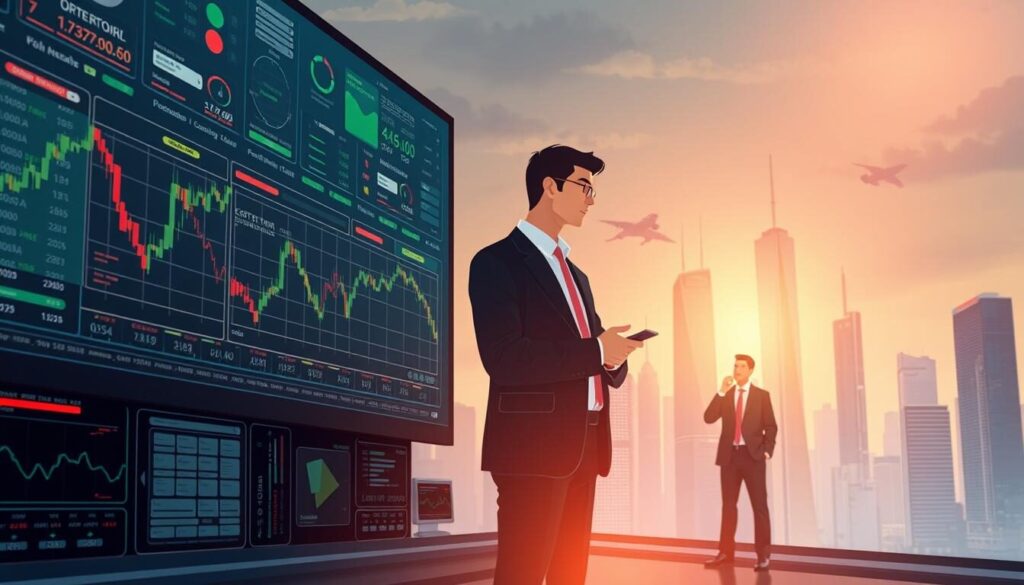Think of your broker like a restaurant. Some serve farm-to-table transparency. Others? Let’s just say there’s a mystery meat special. The way your orders get processed—whether they hit the global market or stay in-house—changes everything. Your spreads, risks, even your morning coffee’s bitterness level. (Okay, maybe not the coffee.)
Today, we’re cracking open three business models shaping your trades. One routes your deals to big-league banks. Another plays house, matching orders internally. The third? Let’s call it the middleman with a commission twist. Spoiler: Your stop-losses have opinions about which model they prefer.
We’ll use real trading scenarios—like why certain platforms love volatile markets more than others. Ever notice how some brokers suddenly widen spreads during news events? Yeah, that’s not coincidence. It’s business strategy wearing risk management pajamas.
Key Takeaways
- Transparency varies wildly between order routing methods
- Internal trade matching creates hidden risks (and profits)
- Commission structures directly impact market access quality
- Liquidity sources determine execution speed and fairness
- Your trading style thrives under specific brokerage models
By the end, you’ll spot broker conflicts of interest faster than a Redditor spots a meme stock. Let’s turn that 73% statistic into ancient history—one informed trader at a time.
Understanding Forex Brokerage Models
Picture choosing between live-streaming a concert or watching a bootleg recording. That’s essentially how brokerage models work—some give you front-row access to real-time markets, others… well, let’s just say the audio might crackle.
When Your Broker Plays Matchmaker
A-Book strategies act like VIP backstage passes. Your orders get routed directly to big banks and liquidity pools. No middlemen. No funny business. It’s like ordering from a restaurant’s actual kitchen instead of the freezer aisle.
B-Book? Think of it as your broker playing house. They become the counterparty to your trades—keeping orders in-house like tangled headphone wires. Convenient? Maybe. But when they profit from your losses, that’s where the plot thickens.
Why Your Coffee Order Matters
Execution speed and spreads depend on this backstage drama. A-Book brokers thrive on market depth—$6 trillion daily turnover means your trades slip through like butter. B-Book models? They’re the diner that secretly owns the farm. Fixed commissions, but questionable ingredient sources.
Here’s the kicker: Some platforms use hybrid models—switching between strategies faster than a TikTok trend. Your job? Know whether you’re getting filet mignon or mystery meat when you click “buy.”
How A-Book Brokers Operate

Imagine your broker as a GPS navigating through Wall Street traffic. A-Book platforms don’t own the roads—they find the fastest route to real market prices. Your orders bypass backroom deals, hitting liquidity hubs where banks and institutions trade trillions daily. No detours. No tollbooth kickbacks.
Direct Access to the Interbank Market
Here’s how it works: When you click “buy,” your broker becomes a digital courier. They bundle your trade with others, shooting it to liquidity providers like JP Morgan or Deutsche Bank. Think of it as UberPool for financial markets—you share the ride, but everyone gets the same fare.
Real-world example: IG Group routes client orders straight to interbank pricing engines. No secret sauce. Just raw market data flowing faster than a TikTok trend. Spreads stay tight because they’re not inventing prices—they’re mirroring them.
Commission Structures and Spread Markups
A-Book brokers earn two ways: charging per-lot commissions (like a concert ticket fee) or adding microscopic markups to spreads (think gas station coffee vs Starbucks). Either way, their profit’s fixed—your wins don’t hurt their bottom line.
| Feature | A-Book Model | B-Book Model |
|---|---|---|
| Order Routing | External liquidity pools | Internal matching |
| Broker Profit | Commissions/markups | Client losses |
| Price Source | Interbank rates | Broker-set quotes |
| Conflict Risk | None | High |
This setup kills conflict of interest dead. Your broker isn’t betting against you—they’re too busy routing trades to care. It’s why algorithmic traders flock to these models: transparency matters more than free platform skins.
Inside the B-Book Forex Broker Model

Ever played blackjack where the casino’s your only opponent? That’s B-Book brokers in a nutshell. Your trades never hit the open market—they’re handled internally like a high-stakes poker game where the house holds all the cards.
The One-Stop Trade Shop
Here’s how it works: When you click “sell,” your order doesn’t travel to London or Tokyo. It stays in the broker’s backyard—matched against their own liquidity pool. Think of it like eBay without the bidding: instant transaction, questionable price origins.
Three red flags (and one green light):
- Quicker fills than Uber Eats during a snowstorm
- Broker profits when you lose—like a casino banking on house edge
- Some use financial spreadbetting tactics to hedge risks
- Zero commissions—but are you paying in invisible spread markups?
Modern brokers play both sides. Advanced algorithms act like bouncers—routing “dangerous” trades (read: profitable clients) to external markets. Your 100-lot EUR/USD order? That gets special treatment. Grandma’s $500 account? Straight to the in-house roulette wheel.
The kicker? This model requires blind trust. Regulated brokers keep prices honest—but always check their license. Unregulated ones? Let’s just say their “market prices” might be as fictional as Netflix’s dating shows.
CPA vs A-Book vs B-Book Forex Brokers: Impact on Trading and Risk Management
Choosing a brokerage model is like picking a gym membership—some track your progress, others profit when you skip leg day. Your risk exposure and trade outcomes swing wildly depending on who’s handling your orders. Let’s break down how these setups play out when real money hits the table.
Transparency: The Make-or-Break Factor
A-Book platforms operate like glass-bottom boats—you see every pebble beneath the surface. They earn fixed commissions whether you win or lose, aligning interests like synchronized swimmers. No stop-loss hunting. No spread manipulation during news events. Just raw market prices flowing through your charts.
B-Book? That’s the casino where the house always wins. When your trade fails, their profit margin cheers. Studies show 73% of retail traders lose money—a stat that keeps these models humming. The kicker? Some brokers toggle between modes faster than a TikTok dance trend.
Who’s Shouldering the Risk?
Volatile markets turn B-Book operations into tightrope walks. Imagine owing money when 1,000 clients hit jackpot trades simultaneously. That’s why many use hedging strategies—like financial airbags—to avoid catastrophic losses. Meanwhile, A-Book brokers sleep soundly; their risk begins and ends with execution speed.
| Broker Model | Profit Source | Client Risk | Transparency |
|---|---|---|---|
| A-Book | Commissions | Market slippage | High |
| B-Book | Client losses | Quote manipulation | Low |
| Hybrid | Mixed | Variable execution | Medium |
Your trading style dictates which model fits. Scalpers need A-Book’s lightning-fast fills. Casual traders might tolerate B-Book’s quirks for zero commissions. But remember: brokers betting against you have about as much incentive to help as a used car salesman pushing lemons.
Hybrid Models and Innovations in Forex Brokerage

Think of your broker as a smartphone switching between battery modes. Hybrid models flip between A-Book and B-Book strategies like adaptive power settings—saving energy on small tasks, going full throttle for heavy lifting. It’s the financial equivalent of having a self-driving car that knows when to take backroads versus highways.
The Goldilocks Approach to Order Routing
Here’s how it works: Grandma’s $500 trade gets handled in-house like a neighborhood potluck. Your 50-lot EUR/USD monster order? That gets VIP treatment through liquidity aggregators to major banks. Brokers use algorithmic bouncers that check three things:
- Account size – Is this pocket change or a briefcase of cash?
- Leverage – Are we dealing with training wheels or a turbocharged engine?
- Risk profile – Does this trader chase storms or picnic in parks?
Top fintech firms like Quadcode now deploy smart order routers that shift strategies faster than a TikTok algorithm. One client’s scalping orders hit raw interbank feeds. Another’s long-term positions get internal matching—like separate VIP lanes at a concert venue.
The magic? Brokers reduce their risk exposure while offering tighter spreads. Traders get execution tailored to their style—the day trader’s espresso shot versus the swing trader’s slow brew. It’s why hybrid models now power 38% of major platforms, according to 2023 industry reports.
This isn’t just having your cake and eating it too—it’s running a bakery that bakes gluten-free and triple-chocolate layers simultaneously. As markets evolve faster than iPhone models, these adaptive systems become the Swiss Army knives of modern trading.
Conclusion
Navigating brokerage models is like choosing between a self-driving car, a taxi, and riding a bike—each gets you there differently. The transparent routing of one model shines in daylight, while others thrive in back alleys of market dynamics. Your success hinges on pairing your strategy with a platform’s DNA.
Scalpers need raw speed—think interbank highways. Casual traders might prefer cozy in-house execution, even if it’s a trust fall with your wallet. Hybrid systems? They’re the chameleons switching camouflage based on your trade size and risk appetite.
Remember: execution transparency isn’t optional. It’s the seatbelt in this rollercoaster ride. Some models offer tighter spreads but hide price manipulation landmines. Others charge tolls for cleaner roads to market liquidity.
Your move? Audit brokers like a detective reviewing security footage. Check where your trades actually go—are they sipping cocktails with big banks or stuck in a basement poker game? The right business model aligns with your goals like Spotify’s algorithm matches your mood.
Pack this intel in your mental suitcase next time you shop platforms. Because in trading, the vehicle you choose determines whether you’re cruising or just spinning wheels. Now go conquer those charts—you’ve got the roadmap.
